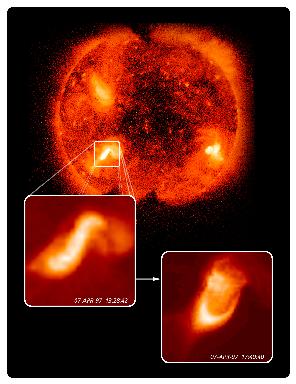
|
Sigmoids are S-shaped structures located in the corona of the Sun. In actuality, the structures appear S-shaped only in the southern hemisphere. In the northern hemisphere these structures appear to have an inverted S-shape and can also resemble an N if rotated 90 degrees. It is believed that these structures occur because of severe twisting of the magnetic field lines in the vacinity. Studies have shown that sigmoid structures are highly likely to erupt within a few days of forming. Sigmoids vary widely in size but are typically 50,000 to 100,000 miles long and easily 10 to 20 times larger than the average sunspot. Sigmoids are observed in X-rays, which means that their temperatures are on the order of millions of Kelvins. Unfortunately, we are unable to detect sigmoids when they first appear over the Sun's eastern limb. Sigmoids are three-dimensional objects that only clearly appear S-shaped when viewed in projection. This typically happens when the region gets within 45 degrees of the central merdian. The image to the left illustrates the eruption of a sigmoidal structure in the corona. The left insert shows the structure on April 7, 1997 13:28:42 UT, before its eruption. The right insert shows the arcade and cusp left behind after the eruption at 17:40:40 UT on April 7, 1997. The cusp is the bright flame-shaped structure towards the bottom left of the image and the arcade is the series of arched loops visible just above the cusp. This image from the Soft X-Ray Telescope (SXT) was prepared by the Lockheed Palo Alto Research Laboratory, the Astronomical Observatory of Japan and the University of Tokyo with the support of NASA and ISAS. |
